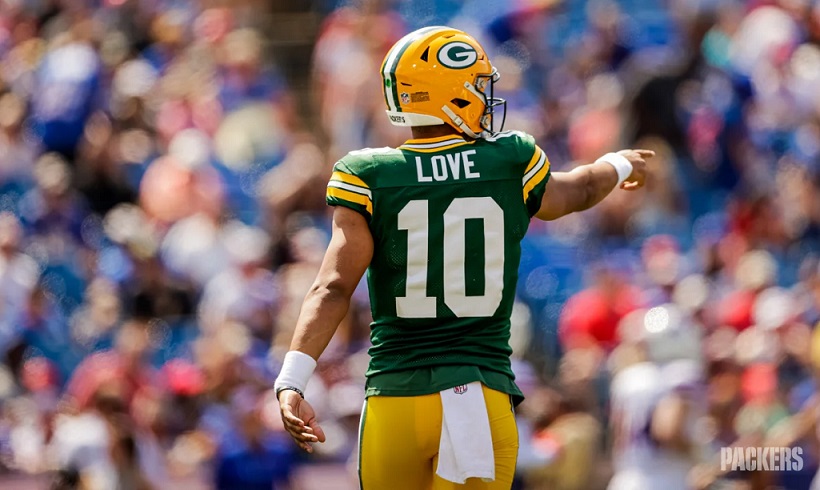When you have a platform in sports, one of your main functions is to analyze what you see. Green Bay Packers writers/podcasters have found themselves lately in a war over predicting the success of Jordan Love. In this realm, no matter what you say, you have to prepare yourself for being told you’re wrong. The cannons are always aimed in your direction in the war over correct analysis.
They’re Coming for You
Watch a game, then take an important play, and focus on what went right or wrong. Let’s take a running play. It’s 4th and inches, and the star runner is stuffed at the line of scrimmage for no-gain. The running back ran right into the back of the left guard and center, defenders got ahold of him, and that was it. At first glance you might think, middle of the line didn’t get enough push, that’s that. Until you play it back and notice on the right side, the guard and tackle opened a gap you could’ve driven a truck through. Looks like the running back hit the wrong gap. Oops.
Is there a positive to take out of this? Yes, look at the right guard and tackle, they just plowed the streets for that Ferrari to cruise on by. The play wasn’t the correct result, but wow, good job fellas, we won’t forget your hard work there.
Take a quick look at the gut reactions out there though. “This line couldn’t block a fly,” “We should cut the left guard, can’t block for crap” “What a stupid play-call, fire the coach.” We see this stuff all the time on Packers social media.
Now hop on your platform and make your analysis. Show what you saw. Pretty obvious right?
Brace yourself. Here they come. Without even looking at the play, there are people out there that will immediately disagree with you. They’ve spent the last 10 minutes blasting the line, blaming the coach, your analysis doesn’t matter. You just complimented two linemen on a play that was a no-gain. Are you blind? Are you stupid? How could you possibly take a positive out of that play?
It may not be popular, but you demonstrated true analysis.

What is true analysis?
In order to truly evaluate a football player, you need to look beyond the play result. In some instances, you might have to know the true play-call. For that, you have to be within the organization to rightfully evaluate it.
How is a Quarterback doing? If you look at the stats and see they completed 8 of 19 pass attempts for 58 yards and an interception, you’d probably think that player isn’t doing well. But then you watch each pass and notice that 6 passes were on the money, but dropped, 3 the defenders just made a great play, 1 the ball was tipped at the line of scrimmage and intercepted, and last, the receiver kept running when he was supposed to turn around. Suddenly, that 8 of 19 looks more like an 18 or 19 of 19. As far as the Quarterback is concerned, he delivered a great ball in the right spot, it was what happened after, that created the end result.
Most great talent analyzers see this from the beginning. It’s a no-brainer to them. We’ve even seen some examples in our recent draft picks.

Rashan Gary has had an outstanding rise. But let’s see a show of hands for who remembers the all-out criticism of the Packers drafting him at 12th overall in 2019. Perhaps the biggest knock against Gary by these “analyzers” was that Gary had only made 9.5 sacks in a three-year college career. Not to mention 3.5 in his junior year before entering the NFL Draft. How could you draft a player that high with that stat line?
The answer is simple. True analysis. The Packers saw how often Rashan Gary was maybe just a few steps away from a Quarterback sack. They saw how with his athletic abilities they could teach him to get passed a defender quicker and become a 10+ sack per year edge rusher.
Now look at 2021’s totals at 9.5 sacks. 2022 he was on track to possibly 12-13 before injury. He has eclipsed those college totals all because his potential was analyzed, and the Packers realized they could help him get better.
Till I’m six feet under I’ll still laugh at the fact that some “experts” predicted Aaron Rodgers fell in the 2005 draft because he “held the ball too high.” Wow, what a mistake.

Correct analysis requires you to look beyond the obvious. Was there another variable at fault for the end-result? Or perhaps is this something that’s easily a teachable moment?
The next time you see an opinion different from yours in terms of a play gone bad, really look at it. Don’t leave anything un-turned. See if you can spot the real reason that play failed. Or watch a player that might be underperforming. Think of why perhaps they might be in that situation. What could help them be better?
These are qualities that make figures like our GM, Brian Gutekunst great. He saw that gem waiting to be plucked with Rashan Gary. He saw DeVondre Campbell waiting to have an All-Pro season if given that chance. He saw Rasul Douglas sitting on a practice squad and thought, he’s going to be an excellent cornerback for us. Most recently he saw Keisean Nixon, an afterthought Special Teams player and realized, that he could be a weapon.
You have to think fourth-dimensionally. You have to look outside the stat-line results.
These are the thoughts that help you win the war over correct analysis.
Greg Meinholz is a lifelong devoted Packer fan. A contributor to PackersTalk as well as CheeseheadTV. Follow him on Twitter at @gmeinholz. for Packers commentary, random humor, beer endorsements, and occasional Star Wars and Marvel ramblings.
——————

